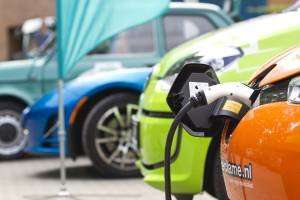Plug-in hybrid vehicles are better than their reputation

Hybrid vehicles are often considered the fig leaf of electric mobility. However, plug-in hybrids with a real electric range of about 60 km drive the same number of kilometers electrically as battery electric vehicles. Hence, their carbon dioxide reduction potential also is the same. This is the result of a comparison of battery and plug-in hybrid vehicles in Germany and the US by scientists of Karlsruhe Institute of Technology (KIT) and Fraunhofer ISI (Fraunhofer Institute for Systems and Innovation Research), which is now reported in Nature Scientific Reports.
Apart from approximately 50,000 purely electric cars, roughly 40,000 plug-in hybrid vehicles are presently being operated on German roads. These hybrids combine a conventional internal combustion engine with a battery. They are often regarded rather critically by environmental organizations and political decision-makers, as they are no "real" electric cars and are supposed to have a poorer environmental record. A systematic empirical comparison of the electric performances of battery vs. hybrid vehicles has been lacking so far.
This gap in research has now been closed by scientists of the Fraunhofer Institute for Systems and Innovation Research ISI and Karlsruhe Institute of Technology (KIT): They compared the performances of 49,000 battery electric cars and 73,000 plug-in hybrid vehicles in Germany and the US using data from fleet trials and automotive manufacturers as well as from websites for drivers to manage and monitor their vehicles.
Data evaluation revealed that plug-in hybrid vehicles with a real electric range of about 60 km drive the same number of kilometers electrically as battery electric vehicles, namely, up to 15,000 km per year. Consequently, their CO2 reduction potential is just as high as that of battery electric vehicles. This means that plug-in hybrids are a good addition to battery electric vehicles in order to reduce greenhouse gas emissions. This particularly applies, if they are charged with power from renewable energy sources. "When taking into account that production of the far smaller batteries of plug-in hybrids is associated with less carbon dioxide emissions than production of the larger batteries of electric vehicles, their carbon dioxide balance is even better," says Patrick Jochem of KIT's Institute for Industrial Production. "Moreover, hybrids can foster public confidence and prevalence of electric mobility, as they have the same range than cars with internal combustion engines, contrary to battery electric vehicles."
Patrick Plötz, Fraunhofer ISI, emphasizes: "Plug-in hybrid vehicles represent a good addition to battery electric cars in order to meet the goal of reducing greenhouse gases. In the past, they were often judged too critically due to lacking empirical data. However, it is important that they have a sufficiently large battery with a real electric range of more than 50 km and, in addition, that the decarbonization of the electricity system is further advanced." According to the study, the decreasing CO2 emissions during battery production and the increasing diffusion of rapid charging points will shift the advantage more and more in the direction of battery electric vehicles in the coming years.
More information: P. Plötz et al. CO2 Mitigation Potential of Plug-in Hybrid Electric Vehicles larger than expected, Scientific Reports (2017). DOI: 10.1038/s41598-017-16684-9
Journal information: Scientific Reports
Provided by Karlsruhe Institute of Technology




















